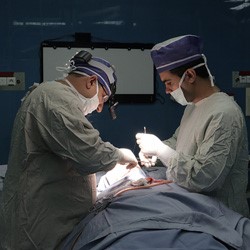GENERAL SURGERY IN IRAN
Despite what the name suggests, general surgery is a specialty mainly related to surgical operations on abdominal organs, although sometimes other areas such as breast, skin and soft tissue, alimentary tract, and endocrine system also fall into this specialty. General surgery can be performed either with the traditional open approach or the minimally-invasive laparoscopic approach, also known as keyhole surgery. If you’re considering having a general surgery in Iran we can help you by facilitating the whole process of traveling and having the surgery at the best hospitals.
Why Iran?
The low cost of general surgery in Iran, coupled with the quality of surgery and skillful surgeons, is the main reason a great number of foreign patients travel to Iran every year to go under the knife. Also, Iran’s hospitable people and great tourist attractions will create a great experience for you while you are on an Iranian medical tour. Iran is also a big name in organ transplantation
Why SinoheMedTour?
The process of traveling abroad for surgery can be very daunting. From getting a visa to going to your hotel after discharging from hospital, there are too much hassle in doing it on your own. SinoMedheTour will do all the arrangements so that you only need to focus on preparing for your surgery.
General surgery cost in Iran
The cost of general surgery in Iran depends on many factors, including the type of surgery, the hospital you choose, and the experience of the surgeon who operates on you, but all in all general surgery fees in Iran are very modest compared to other countries.
What is a general surgeon?
A general surgeon is a doctor and a surgeon who’s trained to care for the whole patient in all the ways necessary, including surgery. They diagnose and manage a broad array of medical conditions before, during and after surgery (preoperative, operative and postoperative care), often as leaders of a team.
General surgery is one of 14 surgical specialties recognized by the American College of Surgeons. While some surgical specialties focus on the technicalities of the heart or brain, a general surgeon is more likely to operate on your abdominal organs or musculoskeletal system, or take care of multiple injuries.
What do general surgeons treat?
General surgeons are like family doctors who can also do surgery, if necessary. They treat a wide variety of conditions, and that treatment includes a wide variety of procedures. If a general surgeon doesn’t feel completely confident in treating a particular condition, they’ll know when to refer you to a specialist.
Conditions
Some of the conditions general surgeons treat include:
- Traumatic injuries.
- Physical abnormalities.
- Breast cancer.
- Conditions involving your upper GI tract (esophagus, stomach and small intestine).
- Conditions involving your biliary tract (gallbladder, bile ducts, pancreas and liver).
- Endocrine conditions (involving your thyroid or adrenal glands).
- Vascular conditions (involving your blood vessels).
- Critical illness and terminal illness.
How do you become a general surgeon?
General surgeons are doctors first, meaning they’ve already completed four years of medical school and earned a degree. To become surgeons, they go on to complete at least five more years in a progressive surgical residency program. Progressive means that completing each year qualifies you for the next.
After completing training, general surgeons must pass two board exams to become certified. First is the qualifying exam, a multiple-choice exam. After passing the qualifying exam, you’re qualified to take the certifying exam, which is an oral exam. When you pass the certifying exam, you become certified.
What does a general surgeon study?
General surgeons study the nine principal components of general surgery, which include:
- The gastrointestinal tract.
- The abdominal and pelvic organs.
- Breasts, skinand soft tissues.
- Head and neck.
- Cardiovascular system.
- Endocrine system.
- Surgical oncology (cancertreatment).
- Trauma (including musculoskeletal, head and hand injuries).
- Critical care and emergency
During training, general surgeons must spend at least four-and-a-half of their five years working with patients. At least three years must be concerned with the nine principal components of surgery. They can’t spend more than 12 months in any surgical specialty or six months in any nonsurgical discipline.
What do general surgeons do?
Once a general surgeon is in practice, the procedures they routinely do may vary, depending on where they work. Some larger medical centers might delegate certain procedures to surgical specialists. In centers that don’t have as many specialists, general surgeons might do more of everything.
Surgeries
Some of the common surgical procedures you might expect a general surgeon to perform include:
- Anti-reflux surgery (Nissen fundoplication).
- Appendix removal (appendectomy).
- Bariatric (weight loss) surgery.
- Breast surgery
- Exploratory surgery (laparotomy or laparoscopy).
- Gallbladder removal (cholecystectomy).
- Hernia repair surgery.
- Prostate removal (prostatectomy).
- Spleen removal (splenectomy).
- Uterus removal (hysterectomy).
Methods
General surgeons today train in the latest technology-assisted operative techniques, including:
- Endoscopy.
- Laparoscopic surgery.
- Robotic surgery.
Endoscopy
Endoscopy allows a surgeon to perform small operations without cutting through your skin or tissues. Instead, they operate with long, narrow tools through an endoscope, a long, flexible tube with a video camera on the end. The endoscope enters your body through your throat (upper endoscopy) or through your anus (colonoscopy). It projects video to a screen, and your surgeon operates guided by the screen.
Common endoscopic surgery procedures include:
- Removing polyps or tumors (polypectomy).
- Removing tissue samples (biopsy).
- Cutting into a clenched muscle to release it (myotomy).
Laparoscopic surgery
Laparoscopic surgery is a minimally invasive surgery technique. A surgeon accesses your abdominal organs through small “keyhole” incisions no more than half an inch long. They place a laparoscope, which is a type of endoscope, through one of the holes to visualize the space. The camera projects to a screen, and the surgeon operates with long, narrow tools through another hole, guided by the screen.
Operations that general surgeons commonly perform laparoscopically include:
- Appendectomy (for appendicitis).
- Cholecystectomy(for gallstones).
- Gastric bypass surgery (a weight loss procedure).
Robotic surgery
Robotic surgery is a type of laparoscopic surgery. It uses a laparoscope and long, narrow tools through small keyhole incisions. The difference is that robotic arms operate the tools. The surgeon operates the robotic arms from a computer console within the operating room. General surgeons may learn robotic surgery in their standard training, or they may take additional training to learn it, such as a fellowship.
Maxillofacial Cosmetic Procedures

